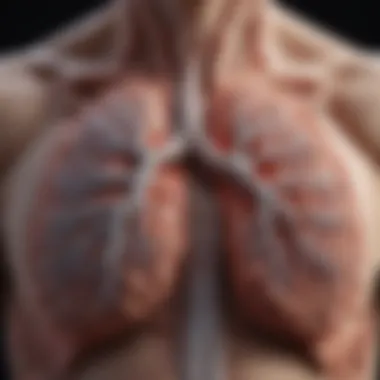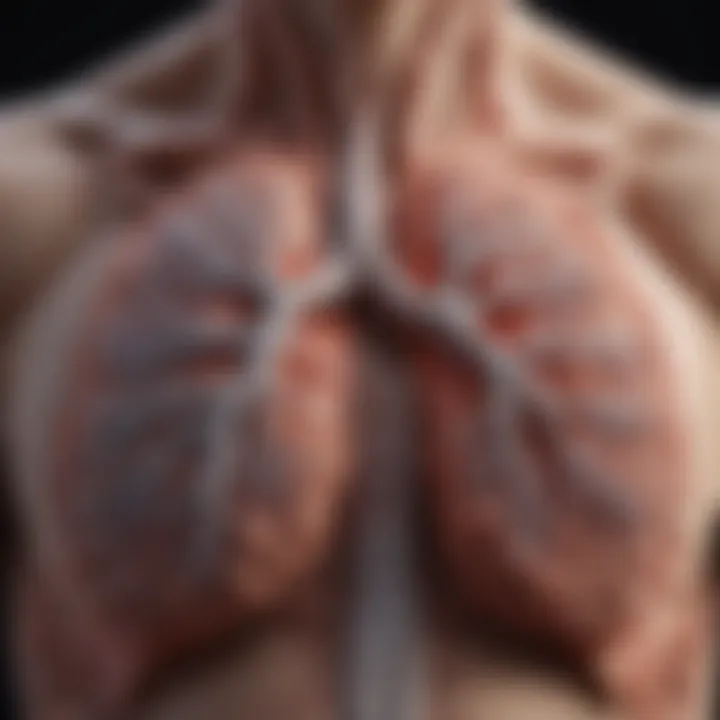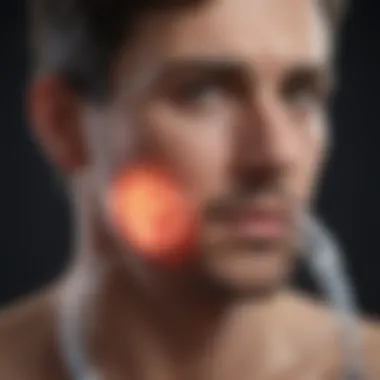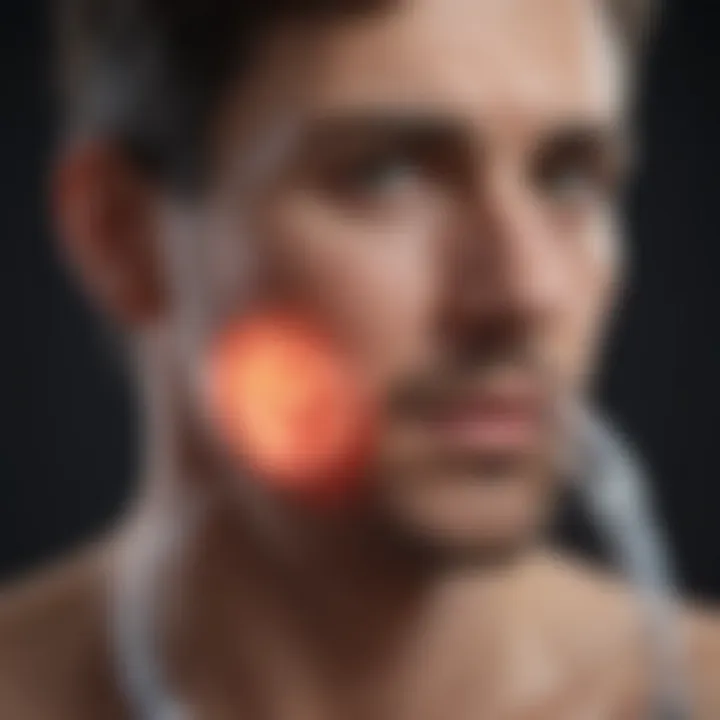In-Depth Insights on Emphysema: A Case Study


Intro
Emphysema, a term often whispered in medical circles, is not just a word tossed around casually. It's a chronic lung condition that gradually steals breath away from those afflicted. In understanding emphysema, it's crucial to delve deep into its mechanics—the whys and hows of its existence in the body.
This article aims to provide an insightful analysis through a clinical case study, portraying not just the medical aspects but also the heart-wrenching effects on patients’ lives.
Overview of Research Topic
Brief Background and Context
To grasp the significance of emphysema, one must look back at its roots. Characterized by an irreversible destruction of alveoli, emphysema leads to diminished respiratory function. According to the Global Initiative for Chronic Obstructive Lung Disease (GOLD), this condition often intertwines with chronic bronchitis, forming a critical component of Chronic Obstructive Pulmonary Disease (COPD). Recognizing these connections provides a more comprehensive frame to explore the complexities surrounding treatment options and symptom management.
Importance in Current Scientific Landscape
Research into emphysema remains absolutely vital today. With increasing cases attributed to smoking, pollution, and even genetic predispositions, the need for a deeper understanding persists. As healthcare professionals continually seek out more effective modalities for management, insights drawn from clinical case studies can illuminate the path forward, encouraging innovative approaches to patient care.
Methodology
Research Design and Approach
This article employs a qualitative research design, focusing on a singular patient case that exemplifies the broader issues faced by individuals living with emphysema. Such a case study method allows for an intimate examination of the nuances involved in diagnosis, treatment, and the overarching realities of living with the disease.
Data Collection Techniques
Data is gathered through various channels. Observations during patient consultations, medical records, and interviews with the patient and healthcare providers contribute to creating a holistic picture. This amalgamation provides not only medical facts but also personal insights into the emotional and psychological challenges faced daily.
"Emphysema is not just about struggling to breath; it's about every moment lost in the fight for air."
By centering on individual experiences alongside established medical data, this article aspires to foster a more nuanced comprehension of emphysema.
Prologue to Emphysema
Understanding emphysema is vital not just for healthcare professionals but also for patients and families affected by this chronic condition. Knowing what emphysema entails helps in recognizing symptoms early, which can lead to more effective management and treatment strategies. This section lays the groundwork for the entire discussion.
Definition and Overview
Emphysema is a progressive lung disease that falls under the umbrella of chronic obstructive pulmonary disease (COPD). It primarily involves the destruction of alveoli, the tiny air sacs within the lungs where gas exchange occurs. Because these sacs lose their elasticity and surface area, the body struggles to expel air, leading to difficulties in breathing. Simply put, emphysema can make a person feel as if they are trying to breathe through a straw.
Patients with emphysema often experience a sensation of chest tightness and can find it challenging to catch their breath, especially during exertion. Many individuals misinterpret their symptoms as simply aging or being out of shape, which delays diagnosis and treatment. Recognizing these early signs can be the first step towards improved outcomes and a better quality of life.
Epidemiology of Emphysema
The prevalence of emphysema varies significantly globally, shaped by factors such as tobacco smoking, occupational exposure to pollutants, and genetics. In the United States, for instance, approximately 3.5 million adults are diagnosed with COPD, a considerable fraction of whom have emphysema specifically.
Some notable epidemiological trends include:
- Age Factor: Emphysema typically manifests in individuals over 40, with higher incidence rates amongst older populations.
- Gender Disparities: There has been a historical prevalence of the disease among men, but the gap has narrowed as smoking rates among women have increased.
- Socioeconomic Impact: Lower socioeconomic status often correlates with higher rates of emphysema, due in part to limited access to healthcare and higher exposure to environmental toxins.
More than 80% of emphysema cases are attributable to smoking—both active and passive exposure. For individuals with a history of smoking, the risk increases dramatically.
Pathophysiology of Emphysema
Understanding the pathophysiology of emphysema is crucial for recognizing how this chronic lung disease affects patients on both a physiological and symptomatic level. The mechanisms at play involve complex interactions between structural changes in lung tissues, inflammatory activities, and underlying genetic factors.
The Role of Alveoli
Alveoli, those tiny air sacs in the lungs, play a pivotal role in gas exchange. In emphysema, these structures become damaged and lose their elasticity. The walls between the alveoli can break down, leading to larger but fewer air sacs. This results in a decreased surface area for oxygen absorption, making it increasingly difficult for patients to breathe deeply.
"The primary defect in emphysema lies in the loss of alveolar surface area, fundamentally impairing the lung's ability to oxygenate blood effectively."
The destruction of the alveoli influences the expiratory phase of breathing. Instead of letting the air out effortlessly, patients may find themselves fighting for each breath, experiencing what is often described as a sensation of air hunger.
Inflammatory Processes
Chronic inflammation is another hallmark of emphysema. It starts with irritants like cigarette smoke, pollutants, or recurrent lung infections, which trigger the immune response. The body sends inflammatory cells, such as neutrophils and macrophages, to the lungs to combat these irritants. While this process is vital for acute protection, in emphysema, it becomes misguided and contributes further to lung damage. The continuous cycle of inflammation results in the release of proteolytic enzymes.
These enzymes, meant to aid in tissue repair, end up destroying proteins crucial for the structural integrity of the lung. Over time, the cumulative effect of this inflammation and tissue destruction is a progressive decline in pulmonary function, leading to the classic symptoms of emphysema: dyspnea and a chronic cough.


Genetic Factors and Deficiencies
While environmental factors play a significant role in the development of emphysema, genetic predispositions are also at work. One well-studied example is alpha-1 antitrypsin deficiency—a genetic condition where the body does not produce enough of this protein, which protects the lungs from damage. Individuals with this deficiency are at heightened risk for developing emphysema at a relatively young age.
In addition, other genetic factors may affect how patients respond to inflammation and injury, potentially modulating the severity of the disease. Understanding these genetic nuances can not only refine treatment approaches but also inform risk stratification among individuals, guiding preventive measures wherever feasible.
In summary, the pathophysiology of emphysema is a blend of structural, inflammatory, and genetic components that together create the landscape of this debilitating disease. By grasping these complexities, healthcare providers can better tailor interventions to improve patient outcomes.
Patient Case Presentation
The presentation of a patient case is a pivotal aspect in understanding emphysema, as it provides real-world context to the often complex theoretical knowledge surrounding this condition. Here, we aim to dissect how this section contributes to the overall narrative of emphysema, illustrating the unique challenges faced by patients, as well as the resulting implications for effective management and treatment. By grounding our discussion in a specific case, we can unveil the intricate nature of this chronic disease, bringing to light elements that statistics alone may obscure.
Significance of Patient Case Presentation
A well-articulated case presentation is not just about presenting facts; it serves as a powerful lens through which we can examine patient experiences, treatment responses, and the nuances of symptomatology. We can better appreciate the challenges and adaptations that accompany long-term management of emphysema. This narrative not only frames our understanding of the disease but also sheds light on the psychosocial factors that are intertwined with the physical dimensions of the condition.
Insights from a specific patient case can lead to a richer understanding of emphysema's heterogeneous nature, allowing clinicians and researchers to better tailor their approaches and consider a more individualized treatment model. This section will delve into three primary aspects: demographics and background, presenting symptoms, and relevant medical history and risk factors.
Demographics and Background
Understanding the demographics of the patient under observation lays the groundwork for interpreting clinical manifestations and treatment responses. For instance, age, gender, and socioeconomic status often play critical roles in how emphysema presents and progresses.
Consider a case where a 65-year-old male, a lifelong smoker, resides in an urban environment, where air quality is less than ideal. Such demographic details are crucial not only for contextualizing the disease but also for making informed choices regarding management strategies.
By focusing on key elements such as the patient’s family background and occupational exposures, it becomes clear how these factors may interplay with the manifestation of emphysema. This information is especially pertinent when assessing genetic predispositions or occupational hazards that may contribute to lung deterioration.
Presenting Symptoms
The presenting symptoms of emphysema can vary dramatically among individuals, offering a unique snapshot of the disease’s impact on one's daily life. Commonly reported symptoms include chronic cough, shortness of breath, and wheezing. However, the subjective nature of these presenting complaints underscores the importance of clinical interviews, as well as the patient's self-reporting.
In our specific case, the patient reports gradual onset of dyspnea—initially during physical exertion but progressively manifesting even during minimal activities. This elevates concerns, as such progression may indicate advancing lung destruction.
"Chronic obstructive pulmonary disease, including emphysema, often compels individuals to adapt their lifestyles, resulting in a host of secondary health measures that may adversely affect overall quality of life."
By detailing the patient's symptoms in a narrative format, we gain precious insight into their lived experience and the impact of the disease on their quality of life. This also drives home the necessity of personalized treatment plans that take into account each patient’s unique symptom threshold and lifestyle.
Medical History and Risk Factors
Understanding the patient’s medical history and their risk factors is paramount in constructing a comprehensive picture of their health status. For example, in our case study, the patient has a notable history of bronchial infections and is a prior athlete. These elements feed into understanding the lung’s baseline state before the onset of emphysema symptoms.
Smoking remains the most significant risk factor linked to emphysema, but other considerations, such as environmental exposures to pollutants or family history of respiratory conditions, need to be factored in as well.
The patient’s past medical records revealing recurrent respiratory issues cater to a clearer understanding of their current lung condition; combined with lifestyle factors such as smoking, this history paints a vivid picture of predisposing elements, which is crucial for future management.
In summary, the patient case presentation encapsulates both the statistical and individual narratives woven into the fabric of emphysema, emphasizing the significance of comprehensive patient assessment. Through demographics, symptoms, and medical history, we glimpse the reality of living with this chronic disease, which can drive more effective clinical responses.
Diagnostic Approaches
The diagnosis of emphysema is not just a walk in the park; it’s a crucial step that lays the groundwork for how the disease will be managed. This section explores different diagnostic approaches used to detect and evaluate emphysema symptoms. These methods help healthcare professionals understand not only the extent of the disease but also the specific characteristics that may inform treatment options. Knowing the nuances of each diagnostic strategy can pave the way for better patient outcomes, ultimately improving the quality of life for individuals grappling with this chronic ailment.
Physical Examination Findings
A physical examination is often the first step in diagnosing emphysema. Physicians generally look for hallmark signs such as decreased breath sounds and prolonged expiration. When a patient presents with wheezing or a barrel-shaped chest, it raises a red flag that further evaluation may be necessary. A thorough examination considers not just the lungs but also the overall physical condition, as emphysema can manifest differently in individuals.
Among the key findings is the patient’s respiratory rate and the presence of cyanosis, which could indicate oxygen deficiency. If a patient appears to be labored while breathing, it can suggest that the airways are compromised.
"The physical examination is like reading the first page of a book; it gives you the context, but it’s just the beginning of a longer story."
Imaging Studies
Chest X-ray
Chest X-rays are a staple in the diagnostic toolkit for emphysema. They provide a bird’s-eye view of the lung structure, often revealing hyperinflation—an indicator that air is trapped in the lungs. A distinctive characteristic of chest X-rays is their ability to show the presence of bullae, which are large air-filled spaces that indicate severe disease progression.
One significant benefit of chest X-rays is their accessibility; they are quick, not overly pricey, and can be performed in various healthcare settings. However, they have limitations. For instance, they can miss early signs of emphysema, making a follow-up with more advanced imaging necessary.
- Advantages:
- Disadvantages:
- Quick and easy to obtain
- Low cost compared to advanced imaging


- May not show early signs of the disease
- Can mislead in cases where other lung conditions are present
CT Scan
CT scans take the cake when further detailing lung structures in emphysema cases. Unlike the traditional X-ray, a CT scan can offer cross-sectional images that highlight the degree of emphysematous change. Their key characteristic lies in their high sensitivity; they can easily detect subtle changes that might escape a conventional X-ray. For instance, airway wall thickening is often identified, allowing for a more nuanced understanding of the disease.
Another unique feature is the ability to assess lung anatomy in three dimensions, providing clearer insights into structural challenges. While CT scans are often deemed a more expensive option, their ability to offer more definitive information about emphysema can be cardinal for providing appropriate treatment.
- Advantages:
- Disadvantages:
- High resolution, providing clearer pictures of lung damage
- Can identify changes that X-rays may overlook
- More cost-prohibitive
- Increased exposure to radiation
Pulmonary Function Tests
Pulmonary function tests (PFTs) are indispensable when confirming a diagnosis of emphysema. They measure how well the lungs are working, focusing on metrics like Forced Expiratory Volume (FEV1) and Forced Vital Capacity (FVC). By quantifying airflow and how well the lungs expand, clinicians can discern the impact of the disease on lung function.
These tests are vital for tailoring treatment plans, as they can indicate the severity of the condition and drive decisions regarding management strategies. It’s through these various diagnostic methods, whether physical exams, imaging, or PFTs, that healthcare providers start to piece together the larger puzzle of a patient’s lung health.
Treatment Modalities
Understanding treatment modalities for emphysema is crucial for managing this chronic disease effectively. The manner in which patients are treated can make a world of difference not only in the disease’s progression but also in overall quality of life. Each treatment option, be it pharmaceutical or non-pharmaceutical, plays a significant role in providing symptomatic relief and improving lung function. The variety ensures that patients receive tailored care based on their unique situations and health status.
Pharmacological Treatments
Inhaled Bronchodilators
Inhaled bronchodilators serve the primary function of relaxing the muscles surrounding the airways, thereby allowing for easier airflow into the lungs. One of the key characteristics of inhaled bronchodilators is their fast onset of action, making them popular among patients experiencing sudden breathlessness. Their effectiveness is illustrated by the immediate relief patients often report after use.
Smooth muscle relaxation leads to wider air passages, allowing for improved ventilation. For many individuals with emphysema, these bronchodilators can be a game-changer. However, while the benefits are clear, some patients might experience side effects like tremors or palpitations. Therefore, healthcare providers must carefully monitor their use to achieve the right balance between benefits and side effects.
Corticosteroids
Corticosteroids, on the other hand, address the inflammation that often accompanies emphysema. These medications are notable for their ability to reduce inflammatory responses, a crucial point for patients dealing with ongoing lung irritation. They are a beneficial choice as they can help minimize the frequency of exacerbations, which, without treatment, can lead to more severe health issues.
A unique feature of corticosteroids is their potentiation of the action of bronchodilators, enhancing the overall effectiveness of treatment. However, long-term use can present its own set of challenges, such as increased susceptibility to infections, so clinicians usually recommend careful monitoring.
Non-Pharmacological Strategies
Smoking Cessation
One of the most critical non-pharmacological strategies is smoking cessation. The main aspect to highlight is that quitting smoking can substantially slow the progression of emphysema. While it’s a simpler statement to say than to do, the benefits are indisputable and there are numerous resources available to aid individuals in this endeavor. This option’s affordability and accessibility make it a popular choice in treatment plans.
The unique feature here lies in the comprehensive support systems, such as counseling and medication options, that are available to smokers. However, a significant disadvantage is the high rate of relapse, which highlights the need for consistent support and robust interventions.
Pulmonary Rehabilitation
Another pivotal approach is pulmonary rehabilitation, a program designed to enhance the physical and emotional well-being of patients. The specific aspect here is its holistic approach, combining exercise training, nutritional advice, and education about lung diseases. This multifaceted treatment is often viewed as beneficial because it empowers patients to take control of their condition.
What makes pulmonary rehab unique is its emphasis on personalized plans and support from healthcare professionals. However, accessibility can be a challenge for some due to geographical limitations or costs involved, which might hinder potential participants.
Surgical Interventions
Lung Volume Reduction Surgery
Lung volume reduction surgery (LVRS) is an intriguing option that directly targets emphysema’s structural aspect. By removing diseased lung tissue, the remaining lung can expand more fully, improving airflow. This process can significantly improve exercise tolerance and quality of life for select candidates. The surgery’s key characteristic is that it focuses on enhancing lung function rather than merely alleviating symptoms, and is often deemed beneficial for patients with severe emphysema.
However, like any surgery, LVRS has its risks, including complications from surgery itself and the potential for longer recovery times.
Lung Transplantation
In cases where emphysema progresses to a critical level, lung transplantation may be considered. This treatment stands out due to its drastic yet potentially life-saving nature. It offers hope for patients whose quality of life has significantly declined and who haven’t responded adequately to other treatments.
The unique feature of lung transplantation is the opportunity for a near-normal life post-procedure. However, this option comes with substantial challenges, like organ availability and the need for lifelong immunosuppression to prevent rejection. These factors can complicate the decision-making process and post-operative care for patients and physicians alike.
In summary, the treatment modalities for emphysema are diverse and require careful consideration of individual patient circumstances. Ails like emphysema can be stubborn, yet with a comprehensive approach combining pharmacological, non-pharmacological, and, where necessary, surgical interventions, patients can find relief and improve their quality of life.


Prognosis and Disease Management
The prognosis and disease management of emphysema play a crucial role in the lives of individuals afflicted with this progressive lung condition. Understanding the long-term outcomes associated with emphysema not only helps guide treatment strategies but also offers patients, families, and healthcare providers a clearer picture of what to expect as the disease evolves. Furthermore, a robust follow-up care plan remains indispensable for sustaining health, preventing exacerbations, and enhancing the quality of life for those living with emphysema.
Long-term Outcomes
Emphysema, classified as a type of chronic obstructive pulmonary disease (COPD), typically results in a gradual decline in lung function. This deterioration often manifests with hallmark symptoms, such as shortness of breath, chronic cough, and fatigue. These symptoms can lead to significant limitations in activities of daily life. The long-term outlook for emphysema patients can vary, influenced by several factors, including:
- Smoking History: The most significant contributor to disease progression where cessation has proven beneficial.
- Age: Older patients may experience more rapid lung function decline.
- Comorbidities: Conditions like heart disease or diabetes can complicate the management of emphysema.
- Treatment Adherence: Regular use of prescribed medications and participation in rehabilitation programs can positively affect long-term outcomes.
The prognosis is often quantified using metrics like FEV1 (Forced Expiratory Volume in one second), which helps gauge the severity of airflow limitation. Studies illustrate that patients with a higher baseline FEV1 tend to fare better in the long run.
"An accurate prognosis requires an nuanced understanding of both physiological and lifestyle factors influencing lung function."
Moreover, a multidisciplinary approach, incorporating health education, nutritional guidance, and psychological support, serves to mitigate the disease impact on an individual’s life. Regular evaluations with healthcare professionals can ensure timely interventions, tailoring management plans to each person's evolving needs.
Importance of Follow-up Care
Follow-up care is a linchpin in managing emphysema effectively. Given the chronic nature of the disease, consistent medical check-ups allow healthcare providers to monitor the patient’s condition closely. This ongoing relationship captivates an opportunity to preemptively address complications or worsening symptoms. Key components of effective follow-up care include:
- Regular Pulmonary Function Tests: Monitoring lung function helps in adjusting therapies to better suit the patient's condition.
- Vaccinations: Ensuring patients receive annual flu shots and pneumococcal vaccinations can prevent respiratory infections that complicate emphysema.
- Education Sessions: Providing patients with knowledge about their condition fosters independence in managing symptoms and recognizing warning signs.
- Support Groups: Encouragement through peer support plays a vital role, creating a sense of community among those facing similar challenges.
Impact on Quality of Life
The interplay between emphysema and quality of life is a significant aspect that deserves thorough attention. This article dives into how emphysema can drastically reshape an individual's daily experiences and emotional well-being. The physical limitations resulting from reduced lung function often come hand in hand with emotional burdens, highlighting the inseparable link between respiratory health and overall life satisfaction.
Psychosocial Considerations
Emphysema doesn’t just affect breathing; it permeates through the fabric of social interactions and mental health. Many patients experience feelings of isolation and frustration as the disease progresses, leading to anxiety and depression. For instance, someone who once enjoyed lively family gatherings may find themselves withdrawing due to embarrassment about shortness of breath. This withdrawal can result in missing out on connections with family and friends, thus intensifying feelings of loneliness.
Patients with emphysema may wrestle with:
- Low self-esteem stemming from physical limitations
- Fear of exacerbations or hospitalizations during social activities
- Stress related to managing their chronic illness, impacting relationships
It's crucial for healthcare providers to not only focus on physical treatment but also to assess and address these psychosocial dimensions. Engaging in supportive therapies can empower patients, helping them find ways to cope with emotional challenges while still maintaining social ties.
Lifestyle Adjustments
Adapting one's lifestyle post-diagnosis of emphysema is vital for managing symptoms and enhancing quality of life. Patients often need to reevaluate daily routines, making adjustments that accommodate their altered physical capacities.
Some lifestyle adjustments may include:
- Exercise programs: Engaging in light to moderate exercises tailored to their ability improves not only physical health but also uplifts mood.
- Nutritional changes: A balanced diet rich in antioxidants can help maintain lung health and support overall wellbeing.
- Oxygen therapy: For some, using supplementary oxygen can make day-to-day activities more manageable, allowing them to participate in previously enjoyable tasks.
To optimize daily living, it can be beneficial for patients to create a list of activities they can safely engage in, prioritizing those that enrich their lives while being mindful of their limits.
"Adapting life to emphysema isn't just about coping; it's about reclaiming joy in small moments."
In summary, navigating life with emphysema requires a holistic approach—one that consciously integrates emotional wellbeing with practical lifestyle changes. This dual focus can profoundly influence how patients experience their day-to-day lives, emphasizing the importance of both physical and mental health in comprehensively managing this chronic disease.
Epilogues
Concluding the exploration of emphysema through a clinical case study holds significant importance for several reasons. The findings drawn from this case are not merely academic; they reflect the very real struggles and adaptations of individuals living with this chronic condition. By compiling evidence from various facets—pathophysiology, diagnosis, treatment, and psychosocial impact—this section provides a holistic view, offering valuable insights to both practitioners and researchers.
One of the pivotal takeaways is the recognition of emphysema as more than just a pulmonary disorder. It permeates the lives of patients, affecting their emotional well-being and social interactions. Understanding this multi-dimensionality is crucial as it drives better treatment modalities that are patient-centered. It’s essential for healthcare professionals to consider not just the physical symptoms but also how emphysema alters one’s quality of life.
Ultimately, this article asserts the necessity of ongoing research in emphysema care. More is needed to fine-tune interventions that could mitigate the difficulties experienced by patients.
"The journey through emphysema is not solely about managing airflow; it encompasses resilience, emotion, and the human spirit."
Summary of Findings
In summation, the case study has illuminated various key aspects of emphysema, including:
- Pathophysiology: We have discerned the intricate workings of alveoli destruction and the consequent impact on respiratory function.
- Diagnosing Techniques: Multiple diagnostic modalities were elaborated, emphasizing the importance of comprehensive evaluations through imaging and pulmonary function tests.
- Treatment Options: A multi-faceted treatment approach was discussed, balancing both pharmacological and non-pharmacological interventions to enhance the patient's quality of life.
- Patient Perspectives: The emphasis was laid on the psychosocial dimensions of living with emphysema, illustrating how the disease shapes everyday experiences.
This collection of findings underscores the imperative of a well-rounded approach to managing emphysema, where the focus should not only remain on physical symptoms but should also embrace the emotional challenges faced by patients.
Future Directions in Research
Looking forward, it becomes vital to advocate for further research focused on several areas:
- Innovative Therapies: Exploration of new pharmacological agents that can better target the underlying mechanisms of emphysema.
- Longitudinal Studies: There is a need for long-term studies assessing the progression of emphysema and its interplay with various environmental and lifestyle factors.
- Holistic Patient Care: Research should also aim to integrate mental health support within standard emphysema treatment regimens, ensuring that emotional well-being is prioritized alongside physical health.
- Genetic Research: Further investigation into genetic predispositions and how they interact with external stressors could lead to personalized treatment strategies.
- Technology Integration: Utilizing modern technology such as telemedicine could provide ongoing support and monitoring for patients, especially those in remote areas.
By exploring these directions, the medical community can strive towards more nuanced and effective interventions that can enhance the lives of those affected by emphysema, bringing us closer to a comprehensive understanding of the disease.



